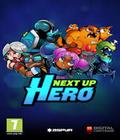At first glance, Next Up Hero looks like another isometric action game. It has some nice cartoon-like visuals with enemy designs to match, and it has a soundtrack that fits the action nicely. Play through a few levels, though, and you'll realize that it has quite a few interesting characteristics that make it feel different from other isometric action titles.
The basic mechanics are of a twin-stick action game. It isn't a proper twin-stick shooter since about half of the characters on the roster sport melee weapons instead of a gun. No matter which weapon type you choose, you'll always have a basic attack, a more powerful one that uses up some attack energy, and an even stronger one that needs to be unlocked. As you journey from level to level, you'll pick up artifacts from fallen enemies that allow you to automatically use and power up secondary abilities, like laying down spikes after every few strikes or temporarily stunning a foe with a shot.
Beyond those basics, there are quite a number of mechanics that make Next Up Hero feel special. The first is that there are barely any stages created by the developers themselves. The game is completely reliant on player-created stages, and even then, the players aren't exactly crafting things like enemy and exit placement. Instead, the game uses keywords to craft randomly generated stages. The chosen words help determine things like the number of enemies you face, how difficult those foes can be, or how long it stays up for public consumption. That last part is noteworthy since the stages consist of multiple levels, and really long stages can have stage counts in the high double digits.
While that may seem like a daunting task for a solo player, you're going through the stages with multiple people in tow. You aren't playing the stages in true multiplayer, though, because the game doesn't work that way. Instead, players go through the stages on their own, and any corpses they leave behind can be resurrected by other players to fight at their side, and vice versa. It feels very much like Demon's Souls in that way, but minus the adversarial aspect. Every floor cleared adds to the overall progress of that stage, so there's a feeling of accomplishment from a group even if it's indirect.
With all of the stages being slightly user-generated, Next Up Hero actually employs overall player leveling as a means of story and ability progression. XP counts more than actual stage completion, and since losing nets you all of the items and XP you've gained, you'll still be able to enjoy the plot if you're bad at the game — as long as you don't mind getting the plot at a much slower pace. While this can be seen as a positive, it means that you'll do a ton of grinding if you're into the narrative.
The grinding is more prevalent because the game is very, very difficult. Enemies hit for lots of HP, and there are no invincibility periods in between hits, so you won't get a reprieve. Get a bunch of enemies together at one time, and you're practically doomed. Melee fighters have next to no chance of getting anywhere, since it only takes a few hits before they're out of the game. Having corpses fight by your side would be nice if they attacked at faster intervals, and the lack of healing means you'll have to play very cautiously even against weak foes. That very high level of difficulty can act as a paradox for an otherwise robust and enjoyable combat system, as you'll restrict yourself to gun-toting heroes just so you can feel like you're getting somewhere in a stage.
There's potential in Next Up Hero. All of the mechanics work well, and even though there's a heavy amount of grind involved, the level variety makes up for that. However, without true multiplayer, the difficulty and amount of damage taken by enemies certainly needs tweaking, as constantly dying at the hands of low-level enemies can quickly get tiresome. Look for more about this game as it progresses toward its summer release.
More articles about Next Up Hero











 Next Up Hero is an arcade-style, beat-'em-up adventure where you choose from a large selection of adorable heroes, fight your way through Rogue-esque levels and, inevitably, die.
Next Up Hero is an arcade-style, beat-'em-up adventure where you choose from a large selection of adorable heroes, fight your way through Rogue-esque levels and, inevitably, die.




